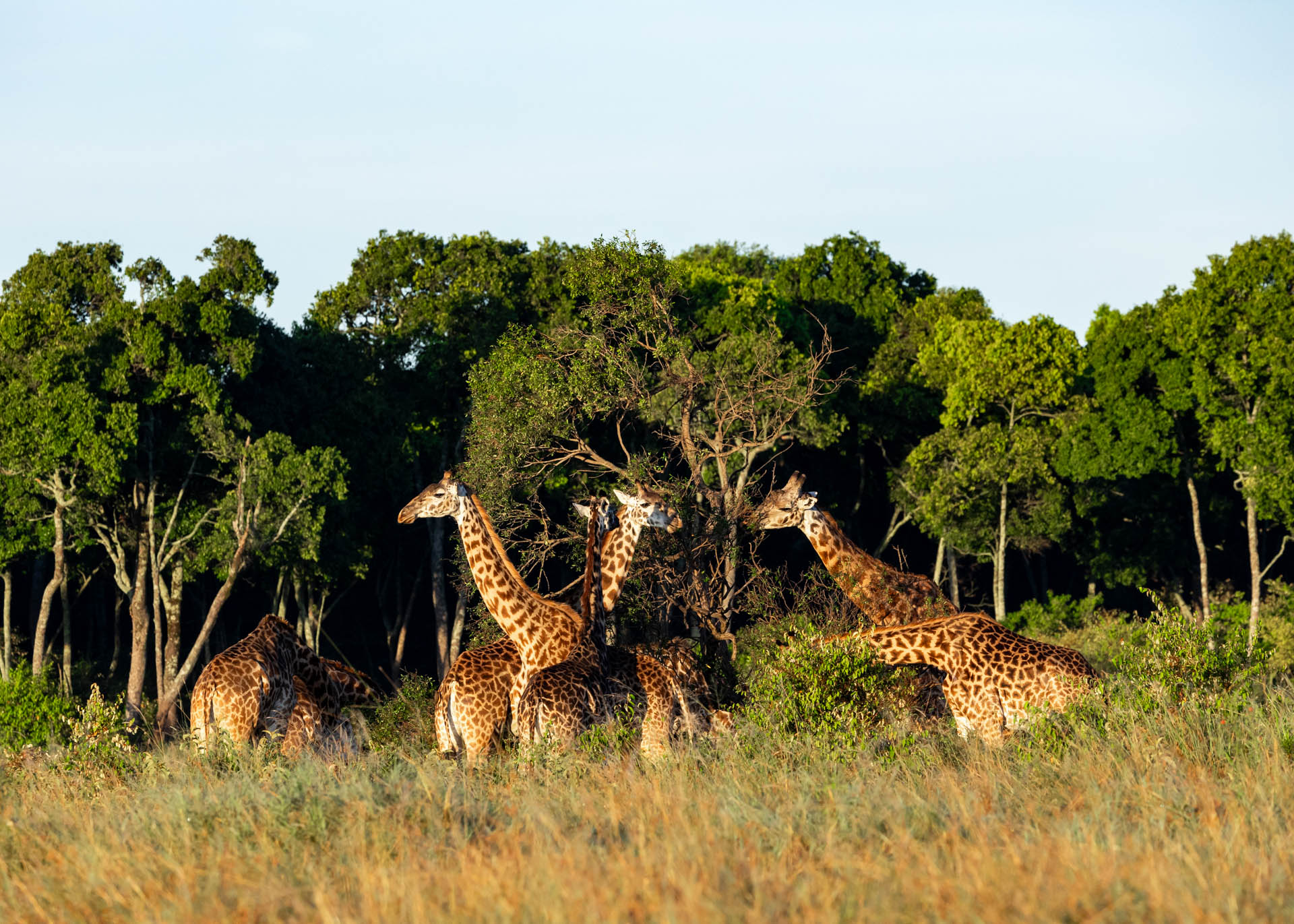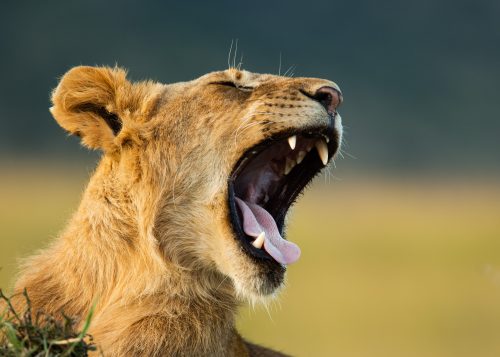Over the past few days, we've been blessed with evening and nighttime rains, leading to stunning African sunrises. Picture this: giraffes clustered around a sweet shrub, southern ground hornbill pairs performing a deep-bass duet with their resonant 'oooh oooh ooh-oh,' and a grey crowned crane, illuminated by the morning light, showcasing its stiff golden feathers and striking white face contrasted with a bright red inflatable throat pouch. Everywhere you look across the plains, the grass appears adorned with dew-covered strands of spider silk, sparkling under the gentle rays of the sun.

The sausage tree (Kigelia africana) is a tropical tree native to Africa that grows 6-12m and produces sausage-like fruits 30-6cm long which hang down on long cord-like stalks. Currently in the Mara, these sausage trees boast long open sprays of wrinkled, maroon trumpet-shaped flowers that are velvety on the inside and virtually overflowing with nectar.
The flowers hang down from branches on long flexible stems and their strong scent attracts bats that feed on the nectar while inadvertently transferring pollen between flowers. After successful pollination, the flowers develop into large, sausage-shaped fruits.
Buffaloes are renowned for their formidable nature, ranking among the most dangerous animals in Africa. Their massive bodies, incredible strength, and aggressive demeanour make them a formidable presence in the wild. They possess strong herding instincts, often rallying together to confront potential threats — including lions. Recently, the Angama lioness and the Owino male were prime examples, compelled to retreat in the face of a determined and defensive buffalo herd.
The trunk of an elephant is an indispensable and highly specialised appendage, serving essential functions such as feeding, drinking and smelling. It is equipped with a complex arrangement of muscles, tissues and nerves that allow them to use their trunk as we do a hand (and even more) making it vital for an elephant's survival. In instances where a portion of the trunk is severed, elephants can still survive, albeit facing significant challenges when feeding, drinking and, in this case, mud splashing.
This mama elephant was probably caught by a snare illegally set up by poachers. Filled with adrenaline created by fear and pain, this elephant probably ripped off her trunk to free herself from the trap. Wild animals have always demonstrated remarkable resilience when faced with life-threatening injuries. We are very grateful for the work that the Mara Conservancy does to remove these snares and protect these beautiful animals from poachers.
Male impalas engage in spectacular battles during the breeding season, known as 'the rut', to establish dominance and access to females. These fights are visually stunning displays of strength and agility, locking horns and pushing against each other with great force which you can see in the video I captured below. During the rut, male impalas gather in bachelor herds, waiting for females to come into oestrus. Ultimately, the outcome of these fights determines which is the dominant male who will have priority access to mating opportunities during the breeding season. Once dominance is established, the victorious male will assert his authority over the bachelor herd and dominance over the females until the end of the rutting period. –Robert Sayialel
The best time to view Kili is usually early in the morning. When sitting in Kimana Sanctuary, the sun rises behind you as you face the mountain to the south and rays of light slowly start hitting the snow on the peak of the mountain. Then, ever so slowly, the light crawls down illuminating the mountain. The ribs or rifts of Kilimanjaro are exposed in the light until the sun comes up. Sunlight bounces off the last remaining glaciers of the Roof of Africa.
Upon further inspection of my images, I could clearly see the glaciers on the top of Kilimanjaro. Some of the famous names are Furtwangler, Rebmann and Decken glaciers. Unfortunately, the decline of one of the tropical glaciers on Kili has been recorded since the 1880s; studies show that over 80% of the glaciers have vanished since then. The primary cause of the retreat is rising temperatures and changes in humidity and precipitation patterns likely due to global warming. This link provides evidence of the decline through satellite imagery. It is estimated that all the remaining glaciers could disappear entirely in the next few decades.
The inception of Angama Amboseli, and one of the key highlights of a visit, is helping to protect the Super Tuskers in and around this area. Just a short drive away, in Tanzania, poaching of Tuskers, the same ones that cross freely into Kenya, is allowed. Creating safe places where these spectacular creatures can freely roam is of great importance and what Angama is actively trying to accomplish here. New grass has attracted many animals into the Kimana ecosystem and in a few months the Sanctuary has been transformed as the grasses are vivid and abundant which, in turn, has brought the elephants.
Zebras and ostriches can both be biological indicators of a healthy ecosystem. These animals play a significant role in maintaining grasslands as grazing patterns promote plant diversity and seed dispersal through droppings. Animals like ostriches are sensitive to environmental changes such as habitat loss or food availability. Here in the Sanctuary on multiple occasions, I have seen groups of ostriches more than twenty strong. There are also plenty of zebras scattered at the base of the mountain including new foals with their brown fur. After nursing for a few months, the foals will begin eating the now-abundant grass.
One of the most interesting things about this ecosystem is the variety of birds — many different from what you would see in the Mara. In multiple locations around the lodge, you can find the golden-backed weaver intricately stitching what seem to be perfect nests. Each blade of grass is chosen with the utmost care as this is how the males attract a female. Around the Sanctuary, we see the distinct red colour of the red-billed hornbill, made famous by the character Zazu in The Lion King. If you look closely, you can see the long eyelashes similar to the ground hornbill (and the cartoon portrayal).
Not only can you identify birds by their appearance but also by their distinctive calls. The laughing dove has a very unique sound made early in the morning — like someone laughing. Associated with the morning, I love this picture as this dove hides among the branches in the warm morning light.
The black-headed heron is a master shapeshifter. Their skinny and slender figure can quickly take a much larger form with their legs and wings extended. They prey on insects and vertebrates such as fish or frogs and even other young birds, so being able to change their presentation is quite helpful.
Last but not least this week was a peculiar sighting of a shell far away from any large body of water. This perfectly shaped spiralled cone is the retired home of an African giant snail. These snails are the largest species in the world and can reach up to eight inches long. They are herbivores and eat a variety of plants and flowers. –Andrew Andrawes
Filed under: This Week at Angama
Subscribe for Weekly Stories
Comments (2):
7 April 2024
The photos are so beautiful out of this world mind blowin

Angama Safari Offers